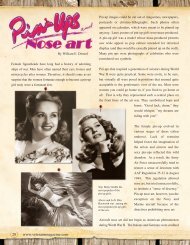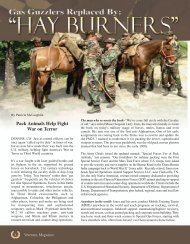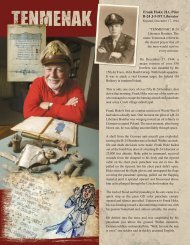In Papua New Guinea, a journalist investigates the - Veterans ...
In Papua New Guinea, a journalist investigates the - Veterans ...
In Papua New Guinea, a journalist investigates the - Veterans ...
Create successful ePaper yourself
Turn your PDF publications into a flip-book with our unique Google optimized e-Paper software.
—or PNG as it's called, sometimes with<br />
affection, sometimes in exasperation—is<br />
<strong>the</strong> kind of place tourist brochures describe as "<strong>the</strong> land that<br />
time forgot." It would be just as accurate to call it "<strong>the</strong> land<br />
that forgot time." Schedules are not rigidly adhered to. <strong>In</strong><br />
<strong>the</strong> capital, Port Moresby, young men with no visible<br />
means of support hang out along <strong>the</strong> roads and markets,<br />
giving <strong>the</strong> place a laid-back feel but making it dangerous at<br />
night. The topography of mountains and jungle, beautiful<br />
but almost impassable, renders national identity elusive.<br />
The six million-plus people—80 percent of whom live in<br />
remote villages—speak about 850 languages, owe allegiance<br />
largely to local clans and eke out a subsistence existence<br />
hunting wild pigs and growing papaw and yams and o<strong>the</strong>r<br />
foods. Many lives have hardly changed from past centuries,<br />
except that cannibalism all but petered out in <strong>the</strong> mid-1970s,<br />
and, with <strong>the</strong> blessings of missionaries, a lot of people now<br />
wear castoff Western shirts and shorts. (It's not unusual to<br />
encounter a fisherman paddling a dugout canoe wearing, say,<br />
a Bucky Badger T-shirt from <strong>the</strong> University of Wisconsin.)<br />
This past May, I visited PNG because I was eager to see <strong>the</strong><br />
country where my fa<strong>the</strong>r was killed in World War II. He<br />
was a war correspondent for <strong>the</strong> <strong>New</strong> York Times—Byron<br />
Darnton was his byline—and <strong>the</strong> troopship he was on was<br />
bombed as it was about to disembark soldiers onto a sandy<br />
beach in October 1942. I was 11 months old at <strong>the</strong> time and<br />
so have no memory of him. But of course <strong>New</strong> <strong>Guinea</strong> was<br />
always more than a dot on <strong>the</strong> map for me. <strong>In</strong> our living<br />
room we had a patriotic globe with stars to mark major<br />
American battlefields. <strong>In</strong> my childhood naiveté, I thought<br />
<strong>the</strong> manufacturer of <strong>the</strong> globe had put <strong>the</strong> one on Buna, on<br />
<strong>the</strong> nor<strong>the</strong>rn coast of what was <strong>the</strong>n called <strong>Papua</strong>, to<br />
commemorate <strong>the</strong> spot where my fa<strong>the</strong>r fell.<br />
<strong>New</strong> <strong>Guinea</strong> was conscripted into war, caught between <strong>the</strong><br />
Japanese and <strong>the</strong> Allied counteroffensive from <strong>the</strong> south.<br />
For <strong>the</strong> most part <strong>Papua</strong>ns did not fight, but both sides<br />
pressed many into service as bearers, carrying supplies and<br />
stretchers of wounded men across mountains and through<br />
miles of steaming jungle. (Their nickname, unthinkable<br />
today, was Fuzzy Wuzzy Angels.) Almost all of <strong>the</strong>m have<br />
36 www.veteransmagazine.com<br />
died by now. Yet <strong>the</strong> war seems anything but remote, largely<br />
because its rusting relics are so much a part of <strong>the</strong> landscape.<br />
Sunken freighters, submarines and troopships rest on <strong>the</strong><br />
bottoms of harbors and hidden bays. The blackened hulls of<br />
bombed-out planes sit beside old airstrips, and debris from<br />
hundreds of crashed planes lies camouflaged in <strong>the</strong><br />
mountainous rain forests and lowland jungles. So many<br />
soldiers died—including many thousands of Japanese never<br />
accounted for—that even today, after heavy rains, villagers<br />
report an occasional skeleton rising up in <strong>the</strong> mangrove<br />
swamps like a mummy in a horror movie.<br />
It's not surprising, <strong>the</strong>n, that PNG has become favored terrain<br />
for war buffs. (Last year, an estimated 4,000 people made<br />
<strong>the</strong> grueling weeklong trek on <strong>the</strong> Kokoda Trail across <strong>the</strong><br />
Owen Stanley Mountains, where Australian soldiers<br />
pushed back <strong>the</strong> Japanese; as recently as ten years ago only<br />
about 100 made <strong>the</strong> hike.) Poking around <strong>the</strong> pillboxes and<br />
overgrown ruins of <strong>the</strong> Japanese bases at Buna and Gona,<br />
Australian, American and Japanese tourists bump into one<br />
ano<strong>the</strong>r, sometimes in awkward silence. Perhaps more than<br />
anything else, PNG has become a hunting ground for<br />
"warbird" enthusiasts looking for missing plane wrecks.<br />
Passionate treasure hunters, <strong>the</strong>y like nothing better than to<br />
hop into helicopters for spotting missions, hack through <strong>the</strong><br />
baking, merciless jungle, debrief villagers and hire local<br />
guides, all for that magical moment when <strong>the</strong>y might<br />
uncover a Kittyhawk or Bristol Beaufighter that dropped<br />
out of <strong>the</strong> sky more than 60 years ago. Among <strong>the</strong>m are a<br />
special breed, <strong>the</strong> salvagers, who not only locate <strong>the</strong> planes<br />
but also extract <strong>the</strong>m, or pieces of <strong>the</strong>m, for export, usually<br />
selling <strong>the</strong>m to museums or to private collectors.<br />
Of all <strong>the</strong> wrecks on PNG, none is as fabled as <strong>the</strong> "Swamp<br />
Ghost," a B-17E Flying Fortress that ran out of fuel on an<br />
ill-fated bombing mission in early 1942 and was ditched in<br />
<strong>the</strong> Agaiambo Swamp about eight miles inland on <strong>the</strong><br />
nor<strong>the</strong>rn coast. There <strong>the</strong> plane rested, intact and more or<br />
less unmolested, in soggy splendor for 64 years—that is,<br />
until May 2006, when an American salvager took it apart






